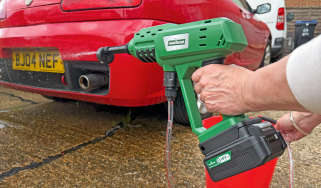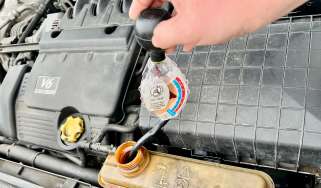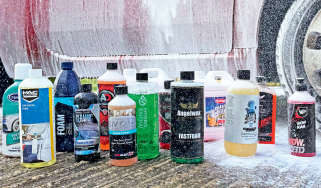Engine oil: how to check and top it up
Failing to check your engine oil levels could turn out to be a costly mistake! Here’s all you need to know to top up your engine oil
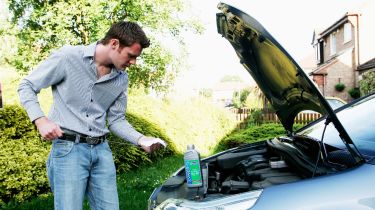
Checking your engine's oil level and topping it up is a simple task, but one of the most important DIY car maintenance jobs you can do. Oil is the lifeblood of your engine and works hard to keep it in good working order, so it’s extremely important that the oil itself is in good condition, and that there’s enough of it. Failing to have enough engine oil can be a costly mistake, which can lead to the engine block seizing or destroying itself.
Regularly checking your oil is an easy way to ensure your car continues to run as smoothly and efficiently as possible. Fortunately, checking and topping up oil is a quick and easy job. Here’s how it's done…
What is engine oil used for?
Engine oil has lots of different uses within your car's engine. Not only is it used as a lubricant to reduce wear on moving parts, it also collects dirt, contaminants and microscopic metal particles which are then removed by the oil filter. Engine oil also acts as a coolant for metal components which can’t be cooled by the radiator.
When should you check the engine oil level?
It’s a good idea to check your engine oil levels regularly, or at least every 2,000 miles or so. No car engine is the same, so while one car might be able to go thousands of miles without needing an oil top-up, another might need to be looked at more frequently.
You should also check your oil levels before you take your car on a long journey, as engines with the correct oil levels are generally more efficient. If you are planning on going on a long trip, it’s also recommended that you check your coolant levels, tyre tread depth, tyre pressures and screen wash at the same time.
How to check engine oil (cars with a dipstick)
Firstly, park your car on flat, level ground, and wait for the engine to cool down. This is very important as it will ensure that the oil has time to settle in the engine oil sump, while also giving a more accurate reading. It also guards against fluid and oil reservoir expansion due to heat – if you open the oil reservoir cap while the engine is hot, you risk getting sprayed with oil which could result in burns and a trip to the hospital. If you were to measure the oil while the engine is hot, it might appear that there’s more than is actually present.
Next, open the bonnet and make sure you have some kitchen towel or a cloth to hand. Locate the car’s dipstick – a long, thin metal rod that usually has a yellow or orange plastic handle. This is normally easy to access, but will be separate from the oil filler cap.
Gently remove the dipstick, being careful not to flick oil over the engine and other components, wipe it clean, reinsert it and then pull it out again.
The dipstick has minimum and maximum marks at the end. The design of these marks can vary between cars, but should always be clear to read. A healthy engine should leave an oil mark between the two. Preferably, this will be closer to the maximum end than the minimum end, but neither over or under the two markings.
At this point, check the colour of the oil. Engine oil should be light and golden in colour. If it’s dark or black, then it’s getting old and you should consider having it changed.
It is common for engine oil in diesel cars to quickly turn to a dark brown colour because the oil is filtering out soot and other combustion by-products. As long as the oil is dark brown in colour, there is nothing to worry about. If the oil is black in a diesel car, you should consider having it changed.
Once you’ve finished checking the oil, you should firmly reinsert the dipstick back into the engine.
How to check engine oil (cars without a dipstick)
Many modern cars no longer have a dipstick. Some manufacturers, such as BMW, have decided to not fit traditional dipsticks to some models, opting instead for a screen readout.
The method for accessing this readout will vary depending on the car, but as a general rule you will need to go through your trip computer’s menu and find the correct option to display your oil level. Check your car’s owner’s manual for details on how to do this.
Unfortunately, without being able to physically inspect your oil, you will not be able to accurately check its overall condition. Therefore, it is even more imperative that you meet the servicing intervals set by your car’s manufacturer in order to maintain the quality.
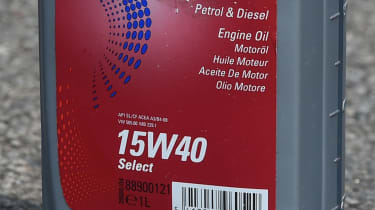
What engine oil does my car take?
Different cars require different types of engine oil, so you’ll need to check your vehicle handbook to find out which specific type you need. If you are unsure, speak to a mechanic who will be able to advise you further, because putting the wrong type of oil in your engine can be an expensive mistake.
If you live or drive in hot or cold weather climates, then you will need an engine oil with a different ‘weight rating’. An oil weight rating refers to the oil’s viscosity or how thick the liquid is. A heavier oil performs better in hot weather, while a lighter oil thickens less in cold weather. Speak to a mechanic or consult your owners’ manual to see which is the best engine oil for your car.
How to top up engine oil
Topping up the oil is very simple. Again ensuring that the engine is cool, unscrew the oil cap, which is usually located at the top of the engine. If you’re unsure about this step, consult your local dealer or check the handbook.
Using a funnel, pour a small amount of oil into the engine, giving it time to settle, then check the oil level with the dipstick. If you still need to add more, simply repeat the process, remembering to add small quantities each time.
Avoid overfilling the engine with oil, as this could lead to significant damage.
If you think you’ve encountered a problem, it’s best to get an expert opinion from a local dealer or garage. Poor maintenance could lead to costly repairs in the future.
Checking engine oil FAQs
Frequently Asked Questions
Generally speaking, you should check your engine oil when your engine is cold, or at least 15 minutes after turning your engine off, as warm oil expands and will give you a false reading.
Giving your engine time to cool down will also allow the oil to settle in the oil pan, providing a more accurate reading of how much oil you have in your engine.
Why not give your car a more thorough going over? Read our guides on How to check your car's engine coolant level, how to repair car paint scratches, and how to change a battery.
Find a car with the experts


